The Biscayan Axe (hache biscayenne)
The Biscayan Axe is by far the oldest and most
traded type of trade axe during the 1580-1763 period in French North America.
Some speculate that Basque fisherman were trading these with the natives in and
around the Gulf of St.Lawrence as early as the 16th century. As such,
many of the early axes made their way into the interior by intertribal trade and
eventually lead to the replacement of the traditionnal stone tomahawk.
A number of adventurers that
were attracted to business, and the close of the century found the first
officially recognized American trading post established at Tadoussac, at the
mouth of the Saguenay River in what is the province of Québec, Canada. During
the first years of the seventeenth century, Samuel Champlain and Sieur de Monts
entered earnestly upon trade and colonization at Tadoussac and elsewhere in the
St. Lawrence and Bay of Fundy (Acadia) regions.
Many contact period trade axes found in Huronia were in fact Biscayan type axes
possibly traded by Champlain or Étienne Brulé in the very first part of the 17th
century. This type of axe should then be considered the first official
trade axe to be used in the interior and along the coastal regions during the
contact period. As such, smaller versions of the Biscayan axe would of
then been used as the very first "tomahawks" (implements of war) to be
used by natives in New-France.
|
Here we have two period
drawings from the Jesuit Louis Nicolas that were made around 1670.
Notice the axes used by both the Algonquian and Iroquois warriors.
These most likely would of been a Biscayan type axe. Notice the
elongated poll as well as the bottom section of the poll that angles
upwards the base of the blade on the Algonquian axe. These are just a few of the
characteristics observed from what we believe is a "Biscayan" type axe which
was manufactured in the Basques provinces either in southern France or northern
Spain. Many reference point to the town of Bayonne as the main
manufacturing center of these axes. |
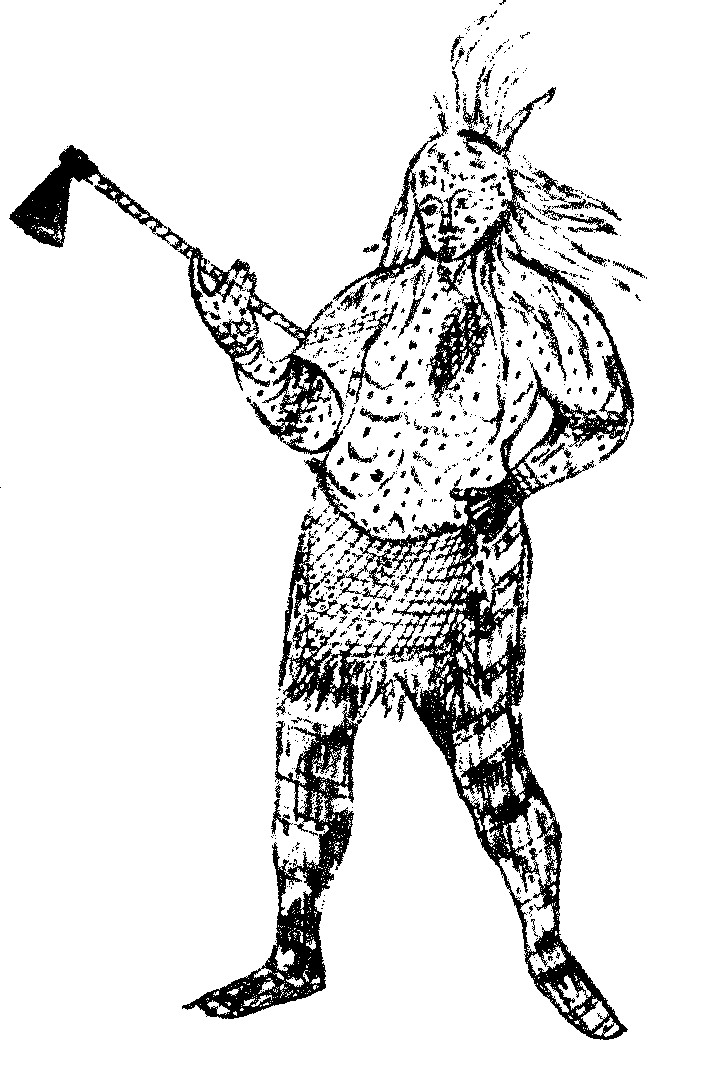 |
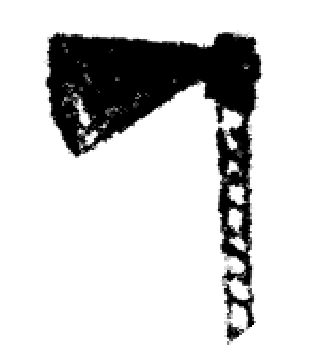
Take note of the
decorative handle which is very similar to the one held by the Iroquois
warrior below. One can speculate as to whether the handle was wrapped with
leather, carved or painted. |
|
Portrait d'un homme de la Nation des Noupiming (Famille
Algonquienne) avec hache de guerre.
Portrait of a man from the
Noupiming Nation (Algonquin Family) with a war hatchet.
Drawing
by the Jesuit Louis Nicolas c.1670,
taken from the Canadensis codex, Montreal,
Editions of the gold Button, 1974. |
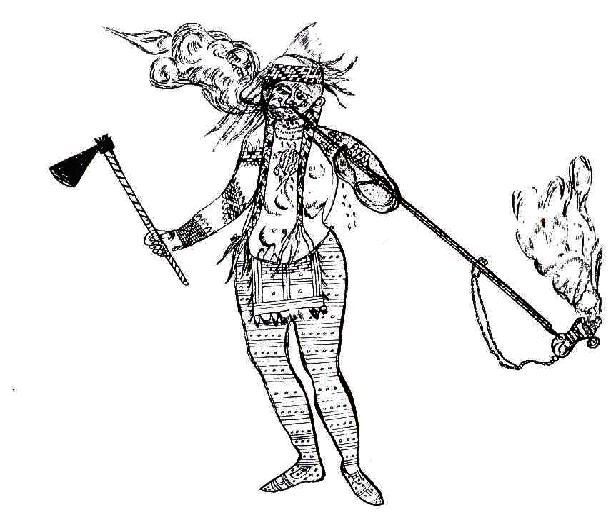 |
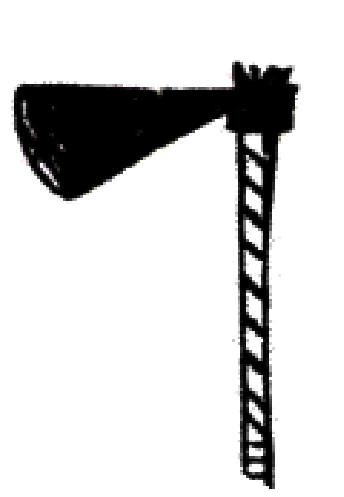
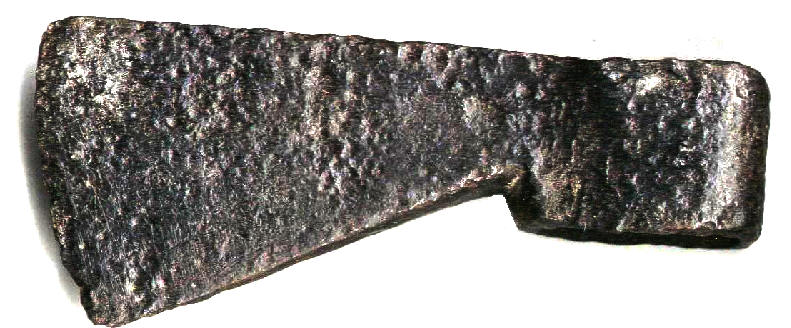
Here is a small
Biscayan type very similar to the one above
recovered from a Seneca (Iroquois) site in northeastern
Pennsylvania, just north of city of Bradford. You will
notice that the width of the blade seems to decrease considerably near
the poll and that the blade is somewhat longer and disproportionate to the
poll as compared to other typical Biscayans. ( 6 1/2 inches long)
|
| Amérindien
iroquois de la tribu des Agnier, dessin à l'encre du jésuite Louis Nicolas
c.1670, tiré du codex Canadensis, Montréal, Éditions du Bouton d'or, 1974.
Photo : BNQ Amérindien
iroquois of the Agnier Tribe (Iroquois), drawing
by the Jesuit Louis Nicolas c.1670,
taken from the Canadensis codex, Montreal,
Editions of the gold Button, 1974. |
|
Characteristics of
the Biscayan Axe (hache biscayenne) |
- elongated oval shaped
eye (flattened "egg shaped")
- blade is very thick
near the poll
- over elongated
poll with a distinguishing "V" shaped notch between lower section of the poll and blade
- the bottom line of
the poll may in fact angle up towards the base of the blade
- the ring around the
base of the poll is
- various sizes (small,
medium, large)
- weight varies per
size
- may contain a steel
insert at the tip of the blade
- single metal strap
that is folded on itself and welded together. You can generally see
the weld line down the center of the blade.
- top of the blade will
either be straight or curve slightly downward
- appears to be the
earliest axe type traded with natives especially based on archeological
studies
- the Biscayan axe
could date as far back as 1580 and was used throughout the French Regime
- the size of this type
of axe as well as the thickness of the blade seems to decrease throughout
the French regime
*It
is important to note that structural variations might occur on these
axe and that only certain characteristics above might apply in identifying
it as a Biscayan type axe.
*it is generally hard to
distinguish a Biscayan axe from a trade axe from a side view (profile)
unless you compare them from a top or bottom view in which case noticeable
differences will be seen. |
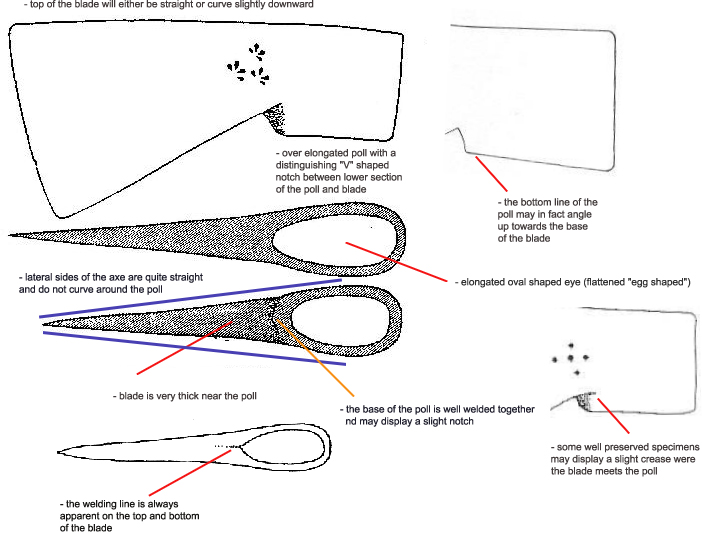
Here are some references to Biscayan axes from various
sources, including the Montreal Merchant's Records Project
reel (excerpts and
English notes/translations by Marie Gerin-LaJoie
(microfilm copy of M496 Montreal Merchants Records Project,
Research Files, 1971-1975, 1 roll - Copy Services,
Minnesota Historical Society Library) as well as
Timothy J. Kent's book "Ft Pontchartrain at Detroit, Volumes I & II".
-
Here we have the minutes of the Hudson's Bay
Company citing Radisson and Groseilliers:
Committee meeting 8th February
1671/2. That Mr. Millington bee desired to take care for providing one
thousand biscay hatchets, one half of three pounds and one half of two
pounds a piece, to bee sure that they bee such as are for trade with indians
and not such as are for the inhabitants of Canada.
And on the occasion of a meeting
November 27, 1673 :
That Mr. Raddison attended Mr.
Millington forthwith with a pattern of biscay hatchets to be provided for
this country, such as are usually sent from thence for France to serve the
Indians in and about Canada, and that Mr. Millington bee desired to give
order for two thousand hatchets to be brought from Biscay by the first
opportunity.
-
The supplies of the Carignan-Salières
Regiment in 1665 included 1,000 Biscayan axes. (Verney, p.136)
-
In
1687, the administrators of New France ordered 128 Biscayan axes.
(N.A.C.,MG 1, Série B, Microfilm F-190, Vol.
13, ff. 3-4)
-
In
November of 1719, the Montreal outfitter Monière recorded the following payment
in his ledger : "Monsieur Dielle, Blacksmith, for 25 large Biscayan axes @ 50
sols (2.5 livres), 62".1
(MMR Monière, Vol.1,p. 83; N.A.C.,MG 23/GIII
25:Microfilm M-847)
-
"Monière
in 1724 had a consignment of trade goods which he supplied to a trade including
36 Biscayan axes of unspecified dimensions as well as 2 large Biscayan axes
priced at 2.5 and 5 livres apiece, respectively".1
(ibid.,pp.431-437)
-
In 1731
"two of Monière's oufits of trade merchandise included such tools; the
invoices recorded a price comparison with other varieties. One of the shipments
contained 3 Biscayan axes, 3 small axes with a steel edge, and 1 large axe with
a steel edge; these versions cost 2, 2.5 and 7 livres apiece, respectively".
1 (MMR, Monière, Vol.
4,pp.79-81; N.A.C.,MG 23/GIII 25:Microfilm M-848)
The second outfit included 12 Biscayan axes valued at 2 livres apiece"1
(ibid.,p. 38-43)
-
Monière
supplied a trader in the Illinois country with 20 small Biscayan axes in 1734,
which cost 2 livres apiece. (ibid., p. 452)
-
Noted in Saint-Pierre's accounts in Charles Nolan Lamarque's
account book from 1 September 1735 to 3 September 1736, Montreal: "20
Biscay axes @40s...........40".
)".(ANQ-M:
Livre de compte de Charles Nolan Lamarque, 1727-1729 et 1734-36, microfilm M-4.)
-
In
1741, "Moniere sent 13 Biscayan axes and 87 trade axes, to the Rainy Lake
post ; each of the 100 latter implements were inexpensive, valued at 2 livres
apiece".1
(ibid.,pp. 58-59,61.)
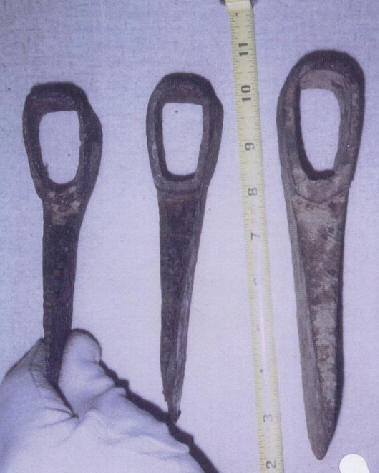 |
|
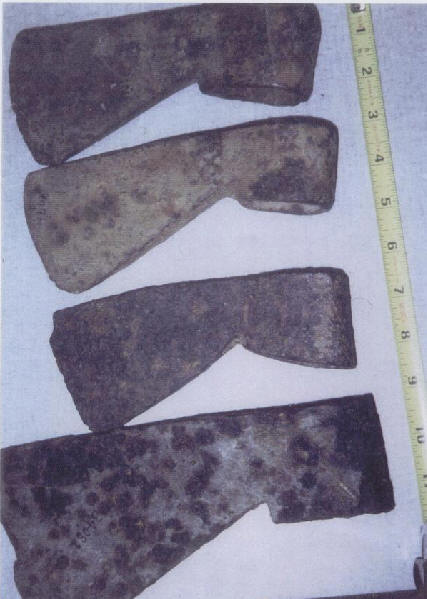 |
| (Top)
Here we have Biscayan type axes in all three sizes: small, medium and
large.(Albany State Museum). *Picture
by Ken Hamilton - Permission given by Ken Hamilton to reproduce.
|
|
(Top)
Here is a view of 3 small Biscayans and 1 large one.(Albany State
Museum). *Picture
by Ken Hamilton - Permission given by Ken Hamilton to reproduce.
|
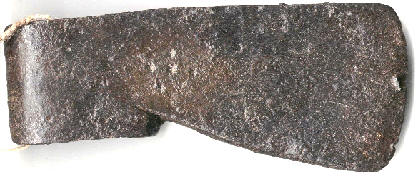
Charles Garrad collection, Canada.
Notice the small crease where the base of the poll and blade join, a
characteristic which is found on some early Biscayans. Found on a Petun site in Ontario dating between 1637 and 1650).
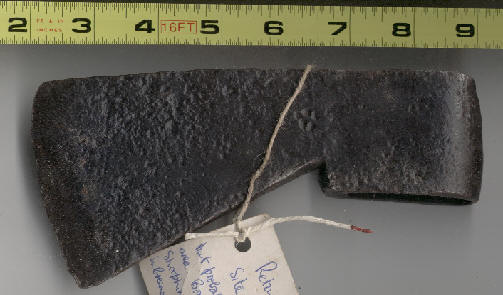
Take note of the exceedingly high poll on this early Petun
axe. (Charles Garrad collection, Canada.
Found on a Petun site in Ontario dating between 1637 and 1650)
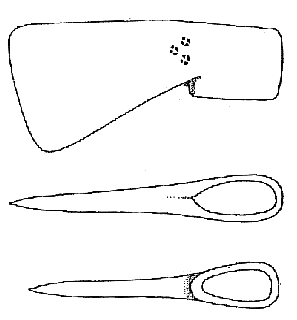
(Here we have a sketch representing a typical biscayan axe with side, top and
bottom view. *Drawing by Tim Kenyon)
(Below)
Here we have a few profile sketches of Biscayan type axes found on French
context sites. Please note that some profile sketches may in fact be very
similar to those of the common trade axe type.
1. Timothy J. Kent, "Ft Pontchartrain at
Detroit, Volumes I & II", Silver Fox Enterprises, 2001.











